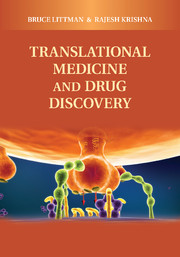Book contents
- Frontmatter
- Contents
- Contributors
- Preface
- Translational Medicine and Drug Discovery
- SECTION I TRANSLATIONAL MEDICINE: HISTORY, PRINCIPLES, AND APPLICATION IN DRUG DEVELOPMENT
- 1 TRANSLATIONAL MEDICINE: DEFINITION, HISTORY, AND STRATEGIES
- 2 TRANSLATIONAL MEDICINE AND ITS IMPACT ON DIABETES DRUG DEVELOPMENT
- 3 CHALLENGES IN ATHEROSCLEROSIS
- 4 OBESITY: NEW MECHANISMS AND TRANSLATIONAL PARADIGMS
- 5 BONE DISORDERS: TRANSLATIONAL MEDICINE CASE STUDIES
- 6 CASE STUDIES IN NEUROSCIENCE: UNIQUE CHALLENGES AND EXAMPLES
- 7 TRANSLATIONAL MEDICINE IN ONCOLOGY
- SECTION II BIOMARKERS AND PUBLIC–PRIVATE PARTNERSHIPS
- SECTION III FUTURE DIRECTIONS
- Index
- References
3 - CHALLENGES IN ATHEROSCLEROSIS
Published online by Cambridge University Press: 04 April 2011
- Frontmatter
- Contents
- Contributors
- Preface
- Translational Medicine and Drug Discovery
- SECTION I TRANSLATIONAL MEDICINE: HISTORY, PRINCIPLES, AND APPLICATION IN DRUG DEVELOPMENT
- 1 TRANSLATIONAL MEDICINE: DEFINITION, HISTORY, AND STRATEGIES
- 2 TRANSLATIONAL MEDICINE AND ITS IMPACT ON DIABETES DRUG DEVELOPMENT
- 3 CHALLENGES IN ATHEROSCLEROSIS
- 4 OBESITY: NEW MECHANISMS AND TRANSLATIONAL PARADIGMS
- 5 BONE DISORDERS: TRANSLATIONAL MEDICINE CASE STUDIES
- 6 CASE STUDIES IN NEUROSCIENCE: UNIQUE CHALLENGES AND EXAMPLES
- 7 TRANSLATIONAL MEDICINE IN ONCOLOGY
- SECTION II BIOMARKERS AND PUBLIC–PRIVATE PARTNERSHIPS
- SECTION III FUTURE DIRECTIONS
- Index
- References
Summary
Introduction
Atherosclerotic cardiovascular disease is the leading cause of death worldwide today. The number of cases of cardiovascular disease is anticipated to increase from 17.5 million to 24.2 million through the year 2030 as rates of obesity and insulin resistance and their associated dyslipidemia (elevated triglycerides and low-density lipoprotein [LDL] cholesterol and reduced high-density lipoprotein [HDL] cholesterol) continue to rise. One proven means of reducing the incidence of cardiovascular disease is through reduction of LDL cholesterol levels. Although currently accepted as a way of reducing cardiovascular disease risk, this has not always been the case. Over the past 50 years, the lipid hypothesis, which states that high LDL cholesterol and remnant lipoprotein levels cause atherosclerotic cardiovascular disease, has had its skeptics. Several competing theories have been proposed regarding the factors responsible for the development of atherosclerosis. The following section will provide a brief overview of several theories of atherosclerosis development and show where we stand today. Much of the evidence supporting the lipid hypothesis has recently been reviewed in detail.
Prevailing Hypotheses of Atherosclerosis Development
The Lipid Hypothesis
Early investigations into the structure and composition of atherosclerotic plaque revealed that plaque is enriched in lipid, including cholesterol. How and why it forms was not initially known. Anitschkow and Chalatow made the serendipitous discovery in their studies on dietary protein that feeding egg yolk and brain to rabbits resulted in atherosclerotic plaque formation. They also noted that these animals had an accumulation of lipid in the liver.
- Type
- Chapter
- Information
- Translational Medicine and Drug Discovery , pp. 62 - 88Publisher: Cambridge University PressPrint publication year: 2011



